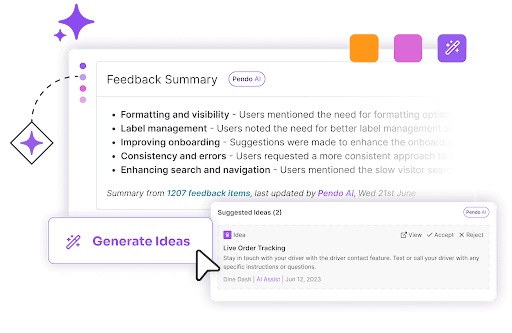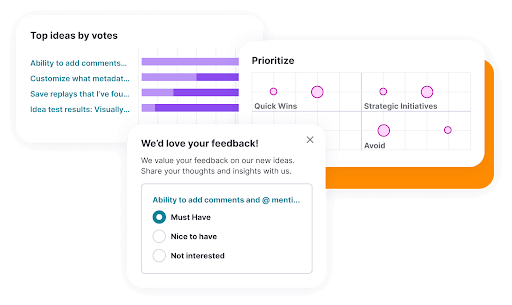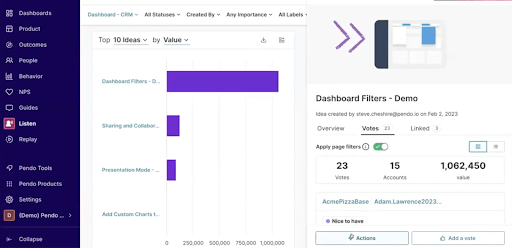We’ve all experienced poor product discovery, whether we know it or not. A UI update that missed the mark, changes to a tool’s favorite feature, or an in-app helper that didn’t catch on. (Remember Clippy? 📎)
Even the best product teams in the world make mistakes, and it makes sense. High volumes of feedback, disjointed data, conflicting priorities—it’s a lot to juggle.
Without contextualized data and unified tools, product teams everywhere are struggling to get a 360-degree view into customer needs. The cost of siloed point solutions is high. Are your users paying for it? Here are three ways to tell.
1. Your product analytics and user feedback are isolated
Unified data isn’t just a buzzword—it’s essential for modern product development. And as your product grows, so does your pool of user feedback.
Product managers (PMs) can spend days compiling feedback and synthesizing data, and still miss something. Without a shared language of data, accessible dashboards, and clear metrics, PMs are only seeing half the picture. You can’t understand what your users want if your qualitative, quantitative, and visual data don’t talk to each other.
Use AI to standardize and contextualize insights
Large companies can’t manage feedback on a one-to-one basis. Yet to understand customer needs, you need a 360-degree view into qualitative, quantitative, and visual data. A comprehensive product discovery tool, like Pendo Listen, gives you big-picture findings and granular details to prioritize and build the right products.
With all of your product data in one place, you can layer insights with the who, what, where, and why. With context you need to turn raw feedback into insights, you can watch replays of user behavior before they submit feedback, look at usage data, and view account information in one platform.
Pendo Listen’s AI assistant is here to help you:
- Clean up and aggregate feedback inputs by automatically creating short titles for each feedback item to understand high-level trends.
- Generate summaries, identify trends, and categorize data. Integrated with your usage analytics and NPS data, you can create views for key user groups, from super users to enterprise accounts.
- Suggest ideas that you can link to specific user feedback items.
Not ready to use AI? You can also set up custom automation rules to speed this up.
2. You don’t know what to prioritize (or how to validate ideas)
You (and AI-powered analysis) surfaced 34 product ideas from your user feedback. Good job! Now, you need to decide what features to invest in. But how can you perform effective validation when your feedback, in-app communication, usage data, and users are all in different places?
Because of these challenges, many teams skip validation altogether. The result? Wasting precious time and resources, while your peers are charting ahead.
Validate product ideas in-app with targeted user segments
To make the best development decisions, ask users what they value and want in-app. Pendo Listen’s validate feature allows you to pull insights from feedback and let users vote on different ideas. This way, you can understand what different groups of users want, measure its impact, and understand context with comments.
Pendo One includes participant data to help you answer questions like:
- What do your super users value the most in a new feature?
- What features or improvements do your NPS ‘Detractors’ need to stay as a customer?
- What do your high-value enterprise accounts need from your product?
3. You’re prone to roadmap errors and can’t align teams
Even if you’ve built a validated, data-backed roadmap, chances are you’re getting some questions and scrutiny. Customers are asking for visibility, VPs are poking holes, and engineering is getting derailed by other priorities. Plus, proving the “why” behind your product roadmap can disrupt your normal workflows.
This is especially true for point solutions. With discovery information spread across feedback, validation, and roadmap tools, the manual work (and re-work) leaves you prone to errors and wasted time.
Close the loop, prove your roadmap, and align developers in one place
What if you could send all of your feedback and validation data to your roadmap in just a few clicks? With Pendo Listen, building a data-backed roadmap is quick and painless.
Instantly transfer contextual information, share it with your organization, and update priorities easily. Pendo Listen also connects with other tools in your workflow, like Jira, to give your developers the context and requirements they need to start strong.
But what about your users that shared feedback, or participated in validation? Unlike other tools, it’s easy to close the feedback loop in Pendo Listen with segmentation and in-app guides. Here are a few ways to update your users:
- Send users in-app communication about the status of their feedback requests
- Share short-term workarounds via in-app guides
- Promote targeted messages to prove user feedback was heard and acted upon
Speed up (and improve the accuracy of) product discovery with Pendo Listen. Take a tour to see how, or request a custom demo.



![[object Object]](https://cdn.builder.io/api/v1/image/assets%2F6a96e08774184353b3aa88032e406411%2F39f3ccde352b460cbf348ccc952054cd?format=webp)


